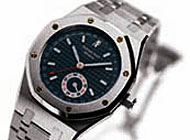A partnership that changed the face of watchmaking

Switzerland's watchmaking industry is heading for a bumper 2000, and one company sharing in that success and making history is Audemars Piguet, which this year celebrated its 125th anniversary.
Audemars Piguet has its headquarters in the village of Le Brassus in the Vallée de Joux, high up in the Jura mountains. The valley is often referred to as the cradle of watchmaking in canton Vaud.
The company has made a name for itself as the maker of some of the world’s most complicated timepieces. It is also one of the few remaining independent watchmakers.
Like a number of Swiss watchmaking firms, Audemars Piguet can trace its beginnings to the lucky meeting of two gifted and ambitious craftsmen, who decided to join forces. The founders were Jules-Louis Audemars and Edward-Auguste Piguet, who were at school together.
Even as a child, Jules Audemars – born in 1851 of Huguenot descent – enjoyed making control mechanisms for complicated pocket watches.
Until 1873, he worked as a “finisher” – one of the top jobs in the watchmaking trade. Finishers were responsible for putting the vital finishing touches to the escapements of chronographs, calendar watches and repeaters.
Thanks to Audemars’ creative work, orders soon poured in from renowned Geneva watch factories, which were interested in dial trains for the more complicated watches.
Audemars was soon obliged to hire watchmakers, most of whom worked at home. One of these was Edward-Auguste Piguet, who also had a passion for horology.
Their association dates from 1875, but it was not until 1881 that the Audemars Piguet company was founded. Audemars was the company’s technical director and Piguet its commercial director and financial expert.
The formula worked so well that it was maintained after the death of the founders. Prime responsibility for technical matters always lay with the members of the Audemars family, while commercial affairs were in the hands of the Piguet family.
While this was an unwritten agreement, it was taken for granted that male members of both founding families would systematically learn the watchmaking trade.
This year the company has been celebrating in style with an exhibition of its most luxurious products being shown around the globe. But the past 125 years have not always been successful and easy.
The president and chief executive officer of the company for the past 15 years, George Henri Meylan, remembers that there have also been hard times.
“In the 1930s, for example, the company nearly closed because of the Great Depression. We had one or two watchmakers working on repairs but no one in production,” he told swissinfo.
“There were no sales, no exports and it was a very difficult time. It was the same story during the Second World War, but since the 1950s we have seen continual growth.”
Much of the company’s success over the past 30 years can be attributed to one model, the “Royal Oak”. It was received with scepticism when it was launched during the great oil crisis in 1972. People wondered whether anyone would be prepared to pay SFr3,650 for a stainless-steel wristwatch.
But the critics were soon amazed as the world’s first deluxe sports watch rapidly established itself.
“It was the first sports watch totally in steel at a high price,” recalled Meylan. “We said we’d make a limited edition of 1,000 and now we’ve made about 100,000. The product was so successful that we couldn’t stop. Now it represents some 40-45 per cent of our sales.”
“Much of the attraction lies simply in the quality of craftsmanship. “Here in this region, we have very skilled people who have patience and can stay at their benches a long time,” said Meylan.
“But these kind of people today are rare. To make complicated watches, you have to be someone who can really concentrate for hours and hours on the same work. It’s not easy to do that.”
The origins of the Royal Oak name are rooted in history. After his defeat at the Battle of Worcester in 1651, King Charles II of England, Scotland, Wales and Ireland hid in a hollow oak tree near Boscobel.
It became a symbol of protection, reliability and strength, with three powerful ships of the Royal Navy also bearing the name between 1802 and 1914.
The “Royal Oak” watch reflects the maritime influence with its octagonal, porthole-shaped bezel.
Audemars Piguet is one of several watch manufacturers in the Vallée de Joux, and it is something of an irony that the watches produced in factories so close to each other end up together in luxury watch displays around the world.
“In this valley there are a lot of different brands. We know each other but we are competitors in the shop windows,” said Meylan. “Our factories are sometimes only 200 metres apart and we are all in the same windows in Tokyo, London, New York, and now in Shanghai or Singapore.
“We have to fight for our space to sell more than the others and that’s something special compared to other industries,” he added.
Today’s watchmakers usually make a point of reinforcing the brand image with their name on the face of the watch. This wasn’t always the case, particularly in the early days of Audemars Piguet, when customers could decide exactly how and where the company should leave its mark.
The firm’s name featured unobtrusively somewhere in the background, usually on the front of the plate under the dial, where the final customer would never see it.
As a result, there are probably many owners of Audemars Piguet pocket watches who are completely unaware of the real origins of their valuable timepieces.
by Robert Brookes

In compliance with the JTI standards
More: SWI swissinfo.ch certified by the Journalism Trust Initiative
You can find an overview of ongoing debates with our journalists here. Please join us!
If you want to start a conversation about a topic raised in this article or want to report factual errors, email us at english@swissinfo.ch.